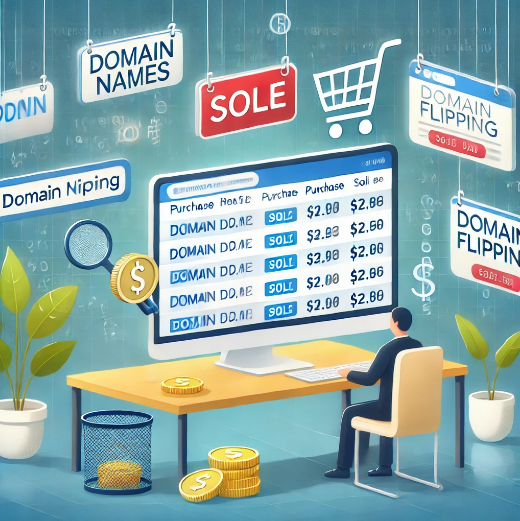In the vast world of online entrepreneurship, domain flipping has emerged as a simple yet profitable venture. Much like real estate, where properties are bought and sold for profit, domain flipping involves purchasing a domain name at a low price and selling it for a higher price. Whether you are a beginner or looking to expand your portfolio, this comprehensive guide will walk you through domain flipping and show you how to make money by flipping domain names.
What is Domain Flipping?
Domain flipping is the process of purchasing domain names (e.g., www.example.com) and selling them at a higher price. Domain names are the addresses of websites, and some domain names, especially those that are short, catchy, or keyword-rich, are considered The idea is to buy domains that have the potential to be more valuable in the future or that already hold intrinsic value and then sell them at a profit.
Why Domain Flipping is Lucrative
Domain flipping can be a highly profitable business for several reasons:
Low Initial Investment: Domain names can be purchased for as little as $10–$15, and some sell for hundreds or even thousands of dollars.
Minimal Maintenance: Once you own a domain, there’s very little maintenance required, unlike physical real estate.
Global Market: The demand for domain names spans the world, and domains can be bought and sold across countries and industries.
Types of Domain Flipping
1. Quick Flipping: This strategy involves buying a domain and selling it as quickly as possible for a small profit. It works well with domains that have immediate value or can be sold to someone who is actively looking for a specific name.
2. Long-term Flipping: This strategy involves buying domain names with long-term potential and holding onto them for months or even years before selling them. Domains related to emerging trends or industries may appreciate over time.
3. Expired Domains: Sometimes domain owners forget to renew their domains, and these domains become available for purchase. Expired domains that have backlinks, traffic, or high domain authority can be especially beneficial for flipping.
Step-by-Step Guide to Domain Flipping
Step 1: Research the Market
The foundation of domain flipping is research. You need to identify domain names that people are willing to pay for. Here are a few things to consider when researching:
Trending Niches: Look for industries or trends with new developments For instance, domains related to blockchain, cryptocurrency, artificial intelligence, or renewable energy may gain more value as these industries grow.
Short and Brandable Domains: Short domains, usually one to three words long, are easier to remember and can be more valuable. Brandable domains that sound like strong business names are also in high demand.
Keyword-Rich Domains: Domains that include popular search keywords, especially in niches like healthcare, real estate, or finance, may attract buyers who want SEO benefits.
Step 2: Choose the Right Domain Registrar
To buy and sell domains, you need to use a domain registry. These are companies that manage the registration of domain names. Some popular domain registrars are:
GoDaddy
Namecheap
Bluehost
Google Domains
When selecting a registrar, consider pricing, ease of use, renewal fees, and customer support. Some registrars also offer features like auctions or domain marketplaces where you can list domains for sale.
Step 3: Register a Domain
Once you’ve identified a promising domain name, it’s time to register it. Easy search for the domain on your chosen registrar, and if it’s available, purchase it. Be sure to check:
Domain Availability: If the domain is taken, some registrars offer alternatives or provide ways to contact the current owner for purchase.
Domain Pricing: Pay attention to both the initial registration fee and renewal fees, as some domains may have higher fees than others.
Step 4: Evaluate Domain Value
Before listing a domain for sale, it’s important to evaluate its potential value. Factors that contribute to a domain’s value include:
Length: Shorter domains tend to be more valuable.
Keywords: Domains with high search volume keywords are more attractive to buyers.
Brandability: If a domain name sounds like a great business name, it will likely fetch a higher price.
Domain Extension: Domains with popular extensions like .com, .net, or .org are generally more valuable than obscure extensions like .xyz or .info.
Traffic and SEO Value: If the domain has existing backlinks or traffic, it could be more valuable to businesses looking for an SEO boost.
Several online tools can help you estimate domain value:
Estibot
GoDaddy Domain Appraisal
Free Valuator
Step 5: Market Your Domains
Once you’ve registered your domain, it’s time to find potential buyers. Here are a few ways to market your domain names:
Domain Marketplaces: Platforms like Flippa, Sedo, Afternic, and GoDaddy Auctions allow you to list domains for sale. These platforms connect you with potential buyers worldwide.
Direct Outreach: If you believe a domain would be perfect for a specific company or individual, consider contacting them directly via email or LinkedIn.
Social Media: Promote your domains on social media platforms like Twitter, LinkedIn, or even niche groups related to domain investing.
Step 6: Negotiating and Selling
Once a buyer expresses interest, the negotiation process begins. As the seller, your goal is to maximize profit while ensuring the sale goes smoothly. Here are a few negotiation tips:
Set a Price Range: Know the minimum price you’re willing to accept and the maximum price you hope to achieve.
Be Professional: Respond to buyer inquiries in a timely and professional manner. Clear communication can help build trust and close deals more effectively.
Use Escrow Services: When selling high-value domains, it’s wise to use an escrow service to handle the transaction. Escrow.com is a popular choice for domain transactions, ensuring that funds and domains are exchanged securely.
Step 7: Transferring Ownership
Once you and the buyer agree on a price, it’s time to transfer the domain. Most domain registrars provide a simple process for transferring ownership. Make sure to follow these steps carefully:
Unlock the Domain: Domains are typically locked by default to prevent unauthorized transfers. You’ll need to unlock the domain before transferring it.
Provide an Authorization Code: The registrar will provide an authorization code (also known as an EPP code), which the buyer will use to complete the transfer.
Confirm the Transfer: Both the buyer and seller will need to confirm the transfer through their respective registrars.
Once the transfer is complete and payment is received, congratulations! You’ve successfully flipped a domain.
Common Mistakes to Avoid in Domain Flipping
While domain flipping can be lucrative, there are pitfalls to avoid:
Overpaying for Domains: Don’t buy domains just because they seem cool. Make sure they have real market value.
Ignoring Renewal Fees: Domains have annual renewal fees, so factor these into your calculations when considering a long-term flip.
Focusing on Obscure Extensions: Stick with popular extensions like .com, .net, and .org, as they tend to have more resale value.
Conclusion
Domain flipping offers a low-cost entry into the world of online business with potentially high returns. With the right research, strategy, and persistence, you can turn domain flipping into a profitable venture. By following the steps outlined in this guide, beginners can successfully navigate the domain flipping market and create a steady income stream from the comfort of their own homes.
Remember, success in domain flipping comes with practice, so don’t be discouraged if your first sale doesn’t net a huge profit. As you learn more about what makes domains valuable and how to market them, you’ll get better at spotting opportunities and closing deals. Happy flipping!





